The great outdoors is a truly wild place. Without our technological innovations, we quickly realize just how powerless we are when we are in the wild. In those situations, power, brawn, and size matter a lot more. In the world of strength, there are clear winners and losers, often determined through epic battles.
Today, we are going to compare two of the greatest predators alive today, grizzly bears and wolves. Let’s answer it, once and for all: Can a grizzly bear beat a pack of wolves? Let’s find out together.
Can a Grizzly Bear Beat a Pack of Wolves?
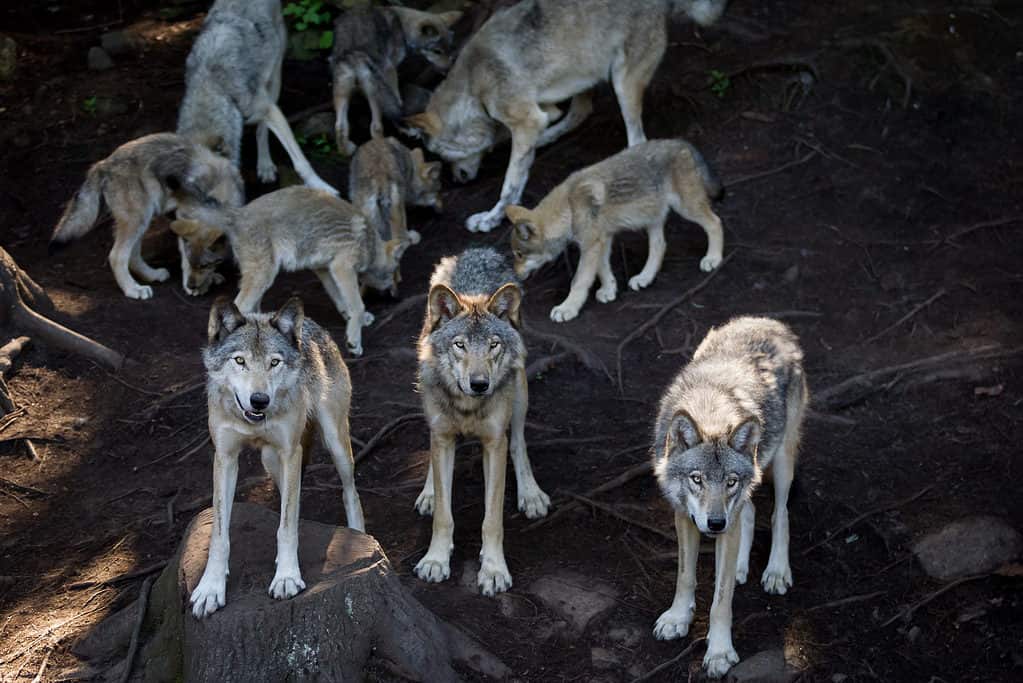
A pack of grey wolves (Canis Lupus).
©PatrickLauzon photographe/Shutterstock.com
Before we get started, it’s important to understand the ground rules here. We all know that a single grizzly would beat a single wolf, but wolves aren’t known for their solitary prowess. Instead, their skill comes from their incredible intelligence and ability as a pack. Knowing that, it is more reasonable to compare a grizzly vs. the entire pack of wolves. An encounter between these two animals is a legitimate possibility, so we are basing the battle on the environment they could actually meet in.
Here are the ground rules:
- The setting is in an alpine region, probably something with trees, water, and meadows.
- The battle is to the death.
- Each side can use any advantage it would naturally use in the wild.
Knowing that, let’s get started!
| Category | Grizzly Bear | Wolf Pack |
|---|---|---|
| Weight | 400 – 600 pounds (male) 250 -350 pounds (female) | 66-180 pounds (male) 51-120 pounds (female) |
| Height | 3.3 ft. (Adult, At Shoulder); 9 ft (Standing Up) | 2.6 – 2.8 ft. (Adult, At Shoulder) |
| Diet | Omnivore | Carnivore |
| Intelligence | Highly intelligent | Highly intelligent |
| Lifespan | 20 to 25 Years (in the wild) | 7-14 Years (in the wild) |
Grizzly Bear vs. Wolf Pack: Size
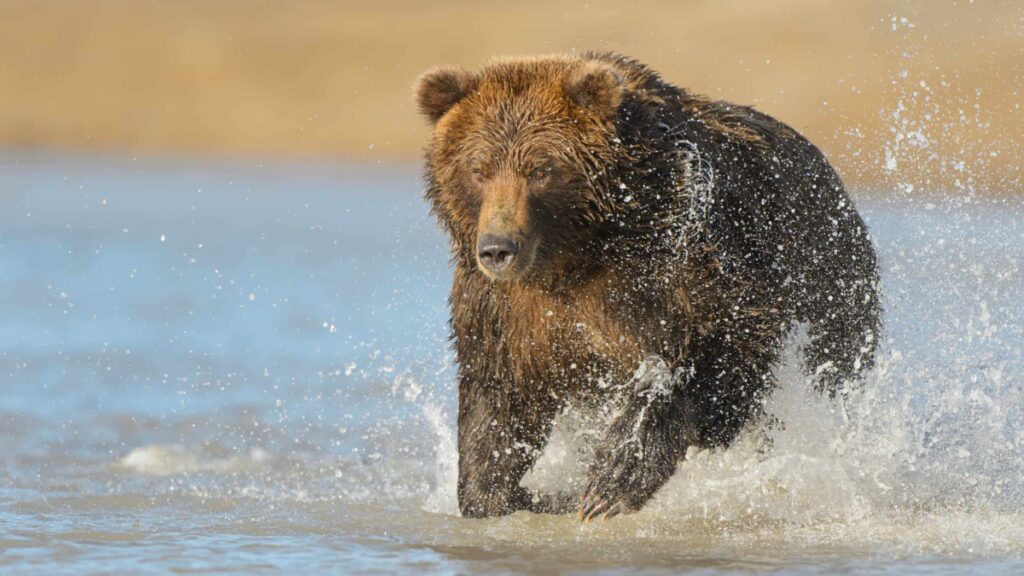
Bears have a massive size advantage over wolves.
©NaturesMomentsuk/Shutterstock.com
Grizzly bears are some of the largest predators in the world. The largest grizzly bears are usually male and can easily grow up to 600 pounds and stand up to four feet at the shoulder.
The largest subspecies of grizzly/brown bears are known as Kodiak bears. These bears live on Kodiak Island, Alaska, and are the second largest bears in the world, only behind polar bears. Kodiak bears can grow up to 1,500 pounds and stand around five feet at the shoulder. When they are standing upright, they are often over 10 feet tall.
Wolves vary by species, but the timber wolf (gray wolf) is the most common across the northern hemisphere. They usually stand around two and a half feet at the shoulder and weigh between 70 and 150 pounds. Individually, wolves are much smaller than a grizzly bear, especially a Kodiak grizzly. But wolves hunt as a pack.
Most wolf packs are between 5-10 individuals, although they can be up to 20 in certain areas. For today’s purposes, let’s assume there are ten wolves in this pack. Using an average of 100 pounds, the total weight of the wolf pack totals around 1,000 pounds, larger than the average grizzly, but less than a Kodiak bear.
Winner: Grizzly bear
Grizzly Bear vs. Wolf Pack: Intelligence

Wolves and grizzly bears are both extremely intelligent.
©iStock.com/Neil_Burton
Bears are easily some of the most intelligent animals around. Despite being big and lumbering, these animals are brainiacs! In fact, many biologists consider bears to be one of the most intelligent land animals in North America. Bears are able to perform complex tasks, make informed decisions, and be self-aware of their own safety and decision-making. For example, bears have been recorded clearing their own tracks during hunting season when they know they are in danger.
Wolves, as many people know, are some of the smartest animals on the planet. These canines are adapted for a social life, a key factor in their insane brains. Wolves can make decisions, hunt as a pack, set ambushes, and understand social cues.
Overall, each animal is equally intelligent, even if it’s in a slightly different way.
Winner: Tie
Grizzly Bear vs. Wolf Pack: Strategy
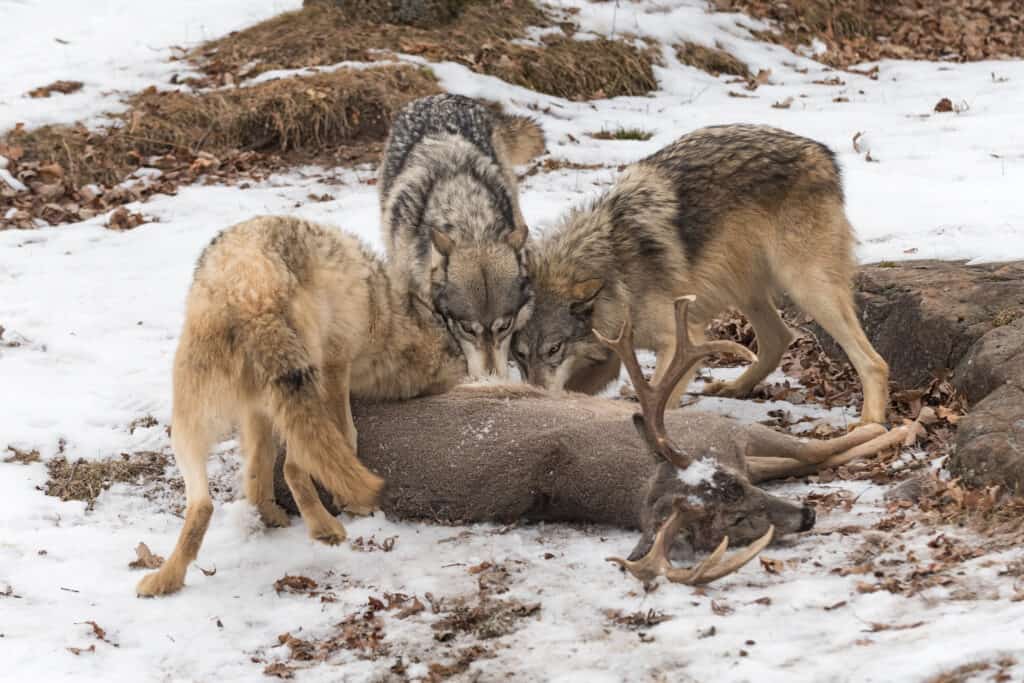
Wolves use strategy in every hunt, while bears are more opportunistic.
©Geoffrey Kuchera/Shutterstock.com
Although grizzly bears are intelligent and apex predators, they are much more opportunistic than we realize. Most of the time, bears will scavenge and eat whatever they can, preferring to avoid other creatures when possible. Although a bear can lay a trap if it wants to, it doesn’t really have a strategy when it comes to fighting; it just uses its strength and size to intimidate others.
Wolves, on the other hand, may be some of the most strategic predators in the world. Hunting as a pack, wolves are known to set traps and ambushes. Examples of this strategy can be seen in their human interactions. A single wolf will get a pet to chase them (usually a large dog), and when the dog has chased the wolf into the woods, the rest of the pack will emerge and surround the helpless dog that has now been separated from its home. Most humans couldn’t think of a strategy as good as that one!
Winner: Wolves
Grizzly Bear vs. Wolf Pack: Special adaptations

Bears are stronger, have a bigger bite force, and have a protective layer of skin and fat. Wolves have higher stamina.
©iStock.com/Jess Bray
Bears have numerous adaptations that make them such formidable foes. To start with, they are strong. Really strong. For reference, a biologist’s tame bear named Brutus has been recorded easily shoving a boulder weighing one ton around. Additionally, bears have a thick layer of skin and fat that protects them from sharp and blunt attacks. One ranger claimed it took six shots from his .357 pistol to kill the bear, and it still maimed him. Even more, grizzly bears have two- to four-inch-long claws and a bite force nearing 1,000 PSI.
Wolves also have some predatory adaptations. One of their best features is their ability to run for extremely long distances. Few animals can outpace a wolf, an advantage they often use when chasing prey like moose and elk to their demise. Additionally, wolves have a bite force of around 500 PSI, although their claws aren’t as sharp as a bear’s.
Winner: Grizzly bear
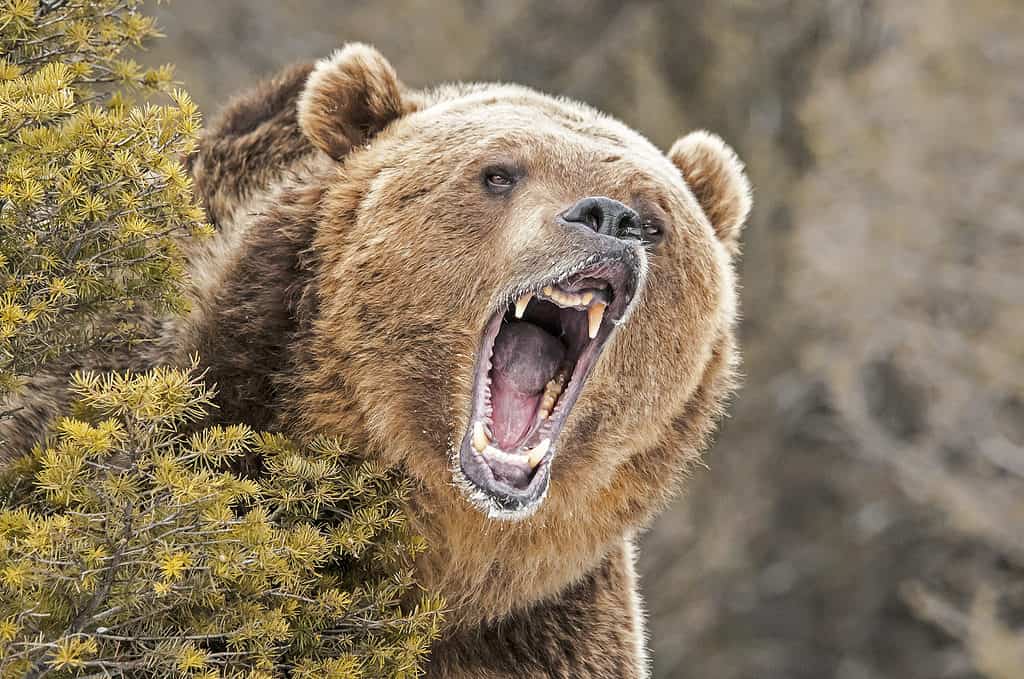
Grizzly bears are omnivores – plants make up a large part of their diet.
©Scott E Read/Shutterstock.com
Grizzly Bear vs. Wolf Pack: Ultimate Winner
The battle would likely take place like this:
With how highly tuned the senses of bears and wolves are, it would be hard for either side to get a drop on the other. The wolves would likely be able to surround the bear as it was moving about the region with the bear being unable to do anything about it.
Once the bear was surrounded, they would close in, pressing the bear into a state where it would begin to try and create space for itself by lunging at the wolves.
Soon, the wolves would begin nipping at the bear, hoping to tire it out. They would have to be quick, as a single blow from a large grizzly bear would immediately kill or incapacitate a wolf. Time would go on, with neither side unable to make progress on the other. Even if the wolves were able to nip the bear quickly, it’s unlikely they would do any real damage.
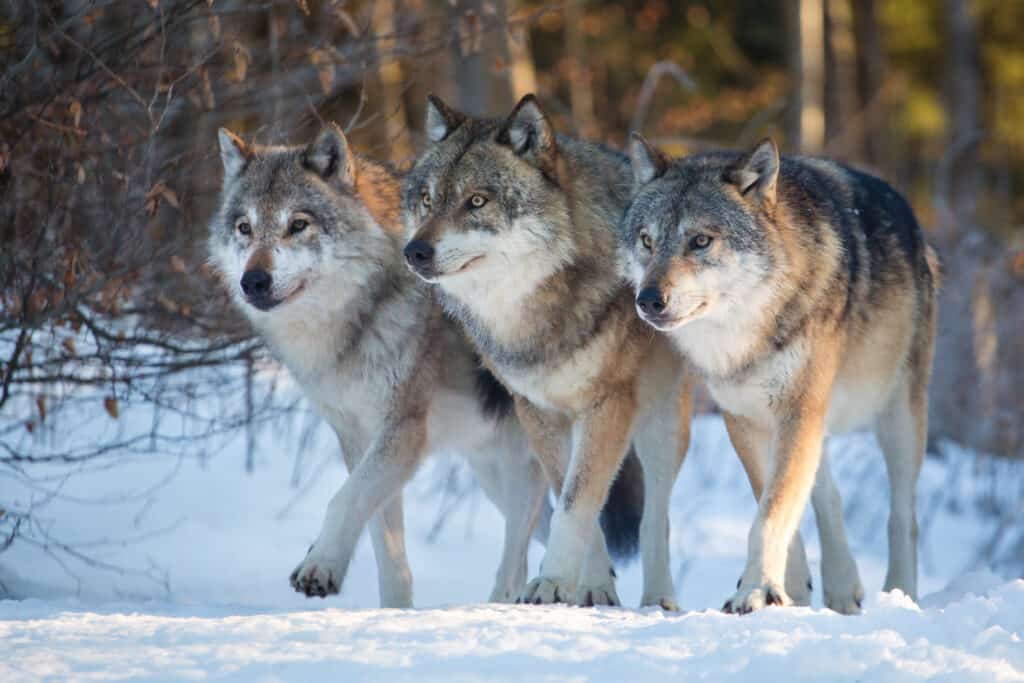
There are two species of wolves in the world; the
red wolf
and the gray wolf.
©David Dirga/Shutterstock.com
Exhaustion Takes Its Toll
The bear and the wolves would fatigue, with the consequences being much more dire for the wolves. In the wild, this is where they would likely part ways, with neither side coming out on top. In a fight to the death, however, this isn’t an option.
At this point, the wolves would begin to get closer to the exhausted bear, especially with their stamina advantage. Once the bear is truly exhausted, the wolves go in for a few more nips. This is where the tides of battle change.
With a single swipe, the bear is able to kill a wolf. Then, as they try again, the bear takes more of the wolves out. Despite their advantages, the wolves have no way to hurt a bear, even when they are given the upper hand. An exhausted bear is life-threatening to a wolf, but a wolf is never truly threatening to a bear.
If the wolves continued to press the attack, the bear would eventually whittle them down. In the end, a massive grizzly bear would come out utterly exhausted, probably a little bloody, but otherwise unharmed amid a circle of dead wolves.
Overall winner: Grizzly bear
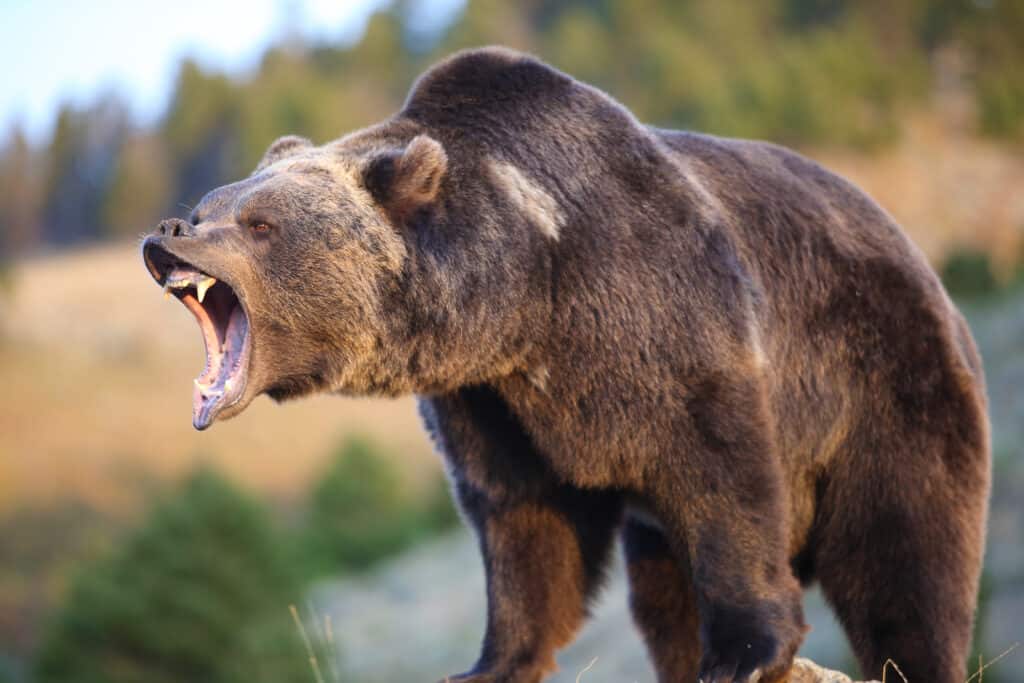
A large grizzly bear would probably beat a pack of wolves in a fight to the death.
©Dennis W Donohue/Shutterstock.com
The photo featured at the top of this post is ©
Sources
- PBS, Available here: https://www.pbs.org/wnet/nature/arctic-bears-bear-intelligence/779/#:~:text=The%20bear%E2%80%99s%20cunning,rocks%20and%20trees.
- Sporting Classics Daily, Available here: https://sportingclassicsdaily.com/defense-against-bears-with-pistols-97-success-rate-37-incidents-by-caliber/
- Brittanica, Available here: https://www.britannica.com/animal/gray-wolf
Thank you for reading! Have some feedback for us? Contact the AZ Animals editorial team.







